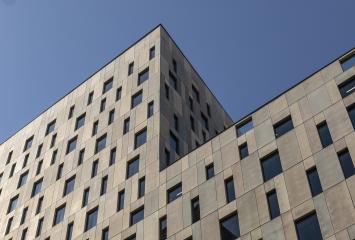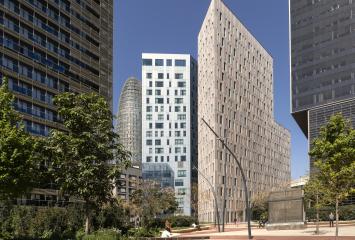The most important changes in offices in the last decades
Fortunately, employee wellbeing has become increasingly important in companies over the last few decades. And offices have been no stranger to this: they have gone from being grey and emotionally flat places to lively and suggestive spaces that energise the inner life of employees. It could not be otherwise. After all, design has a significant impact on the human psyche, influencing levels of satisfaction, serenity, stress, anxiety or boredom. However, of all the changes through which offices have achieved a new, much friendlier, human-centric personality, there are a few that are particularly momentous. Let's get to know them.
Colours matter
Many of the images of offices from the past that remain in the popular imagination are in black and white. But this is no great loss. After all, these offices were marked precisely by black, white and grey. The general idea was that sobriety conveyed seriousness and made workers concentrate more. Some time later we learned that colours, bright colours, variety, informality, are factors that promote relaxation and happiness, which in turn promotes both concentration and creativity. Hence the colour palette of the modern office is infinite. Each has its own personality. And it brings joy and content to those who occupy it in their own way.
Furniture at the service of people
In classic offices, the furniture came first: bland, cold, boring tables and chairs, where workers had to learn to fit in. In today's office, things are very different. Furniture adapts to people through the materials it is made of, the innovation in its geometry, its tones and motifs and, above all, its variety. Chairs have adjustable systems, desks have different heights and there is alternative furniture such as high chairs, armchairs, sofas or even sun loungers and hammocks where workers can sit and enjoy the working day in their own way. It is a much richer environment that makes workers more emotionally inclined to go to the office and enjoy what it has to offer.
Cubicle vs flexible space
That contemporary offices have a wide variety of furniture is no coincidence: it is the consequence of a decisive change of model. Specifically, from the cubicle model, in which the worker was obligatorily and sadly relegated to a corner of the office, to the flexible space model promoted by companies such as Utopicus, in which the worker is free to change the work environment according to his or her preferences. Now an area of sofas, then an area of adjustable high chairs with a coffee machine, then a conventional desk and perhaps in the last two hours of the working day a collective table where synergies can be created. The feeling of freedom inevitably enhances individual well-being. Without freedom we feel incomplete.
Farewell to the baroque
Historically, offices have been baroque spaces: overloaded decorations focused on work, clutter of papers and utensils and an excess of visual, sound and all kinds of stimuli. In contrast, the modern trend in office design proposes much more minimalist, calm, friendly and open spaces. And not only that: the current decoration moves away from the strictly work-related, such as diplomas or photos of the company's history, and moves towards a more home-like decoration based on plants, mirrors or artistic paintings. The intention is to blur the barrier between the professional and the personal. The office is a place to work comfortably. A place with character and nuances that workers can make their own. A second home.
Other important changes
In addition to all of the above, at the forefront of the transition from the classic office to the modern office, there are other obvious developments such as the emergence of leisure spaces within the office (cafeteria area for chatting, TV rooms, gym, recreational areas...), the prioritisation of natural lighting, the search for integral sustainability and, above all, the irruption of technological advances and specifically of proptech. Ultimately, these advances free workers from manual and repetitive tasks and allow them to achieve much higher levels of creativity, interconnection and operability. In this sense, the contemporary office must be and is digital. Because that is where people can flow comfortably and exploit their full potential.
In short, and as we have seen, multiple small design changes have brought about a general revolution: the traditional office was a place to suffer, the modern office is a place to enjoy. A daily reality designed to take care of people and, in this way, to bring out the best in them day after day. There is no turning back.

